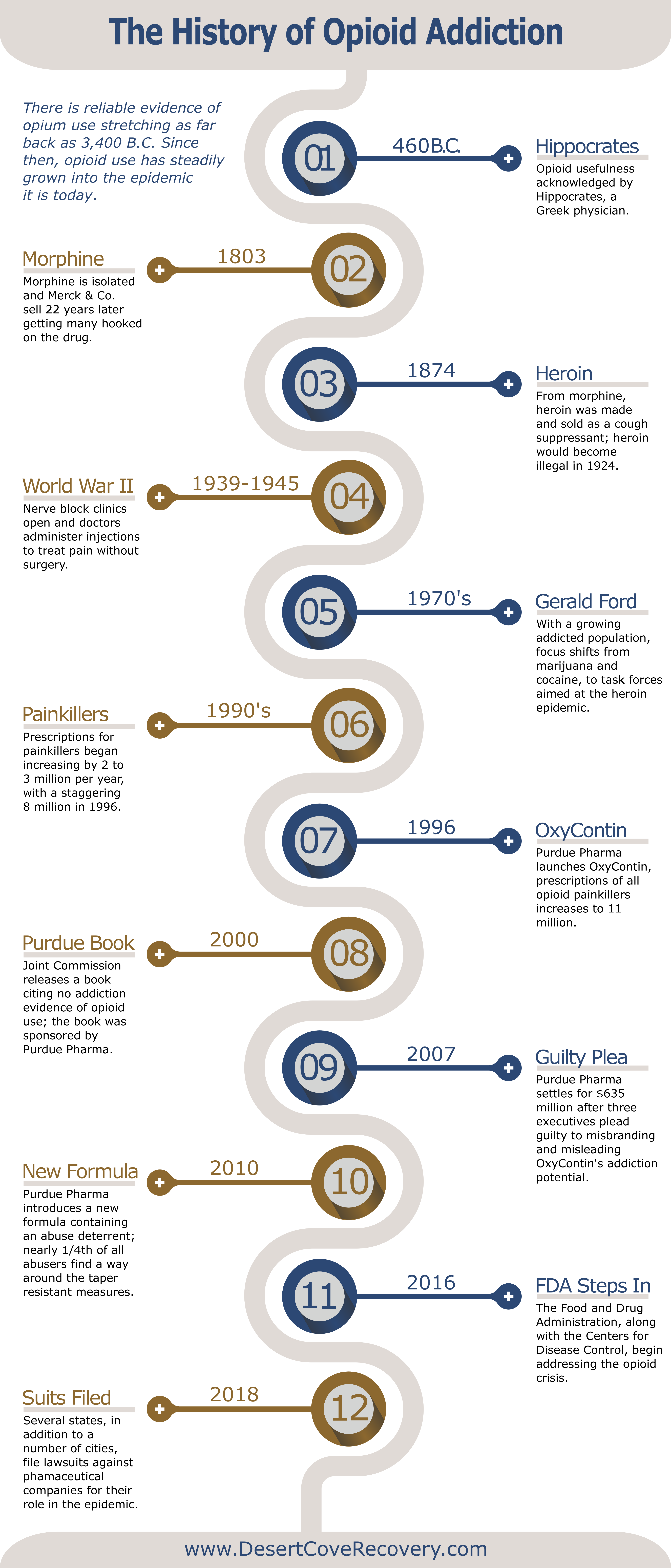Arizona Rehabs Discuss the History of Opioid Addiction
There’s no doubt that our country is in the throws of a crisis. How did opioid addiction begin? Let’s take a look at the history of opioid addiction and how Arizona rehabs are trying to help.
There is reliable evidence of opium use as far back as 3,400 B.C. The opium poppy was called “joy plant,” and it spread from Mesopotamia to Assyria, Egypt and the Mediterranean. In 460 B.C., Hippocrates acknowledged its usefulness. Alexander the Great introduced it to Persia and India, and Arab traders took it to China. The Opium Wars were fought in China from 1839 to 1860.
Opium’s power to alleviate pain has resulted in thousands of years of abuse. In modern history, famous opiate users who battled addiction include Charles Dickens, Edgar Allan Poe, Florence Nightingale, Billie Holiday, Janis Joplin, Elvis Presley and River Phoenix.
Continued after image:

The History of Opioid Addiction in the U.S.
Opiates are an unfortunate part of American history. With the advent of synthetic opioids, the problem only got worse:
- The armies on both sides of the American Revolutionary War gave wounded soldiers opium. In his final years, Benjamin Franklin took it for a painful bladder stone that had tormented him for years.
- Morphine was first isolated in 1803, and Merck & Co. took over commercial production in 1827.
- Morphine and other opiates were widely used by the time of the Civil War. An alarming number of veterans were hopelessly hooked following the conflict.
- Heroin was first made from morphine in 1874. As a cough suppressant, it was hailed as a wonder drug. Bayer Corp. launched it commercially in 1898. Heroin increased in popularity when users discovered that injecting the drug enhanced its effects.
- Doctors were alarmed by climbing rates of drug addiction in the early 1920s. Heroin was made illegal in 1924.
- World War II gave rise to nerve block clinics; anesthesiologists administered injections to treat pain without surgery. The clinics operated during the ‘50s and ‘60s.
- President Gerald Ford set up a task force to study drug addiction in the 1970s. The focus shifted from marijuana and cocaine trafficking to the heroin epidemic.
- Painkillers like Percocet and Vicodin were already becoming a problem by the late ‘70s. Many doctors were reluctant to prescribe them.
Dr. Hershel Jick of Boston University School of Medicine disagreed there was a problem. After analyzing almost 12,000 patients who’d been treated with narcotics, Jick concluded that addiction to opioids was rare in patients with no history of substance abuse. A pain-management specialist, Dr. Russell Portenoy, studied 38 patients six years later and also declared that opioid maintenance therapy was safe.
The two studies sparked a discussion that lasted into the early 1990s. Pain management became a priority for patients.
- Every year in the early 1990s, the number of prescriptions for painkillers increased by 2 to 3 million. Then, from 1995 to 1996, the one-year increase was 8 million.
- Purdue Pharma launched OxyContin in 1996. One year later, prescriptions of all opioid painkillers on the market increased by 11 million.
- The Joint Commission is a nonprofit group that accredits medical facilities. In 2000, as part of doctors’ required continuing education, the commission published a book that cited studies in which there was “no evidence that addiction is a significant issue when persons are given opioids for pain control.” It expressed the opinion that doctors’ concerns about addiction were “inaccurate and exaggerated.”
The book was sponsored by Purdue Pharma.
Dr. David W. Baker with the Joint Commission later remarked, “There is no doubt that the widely held belief that short-term use of opioids had low risk of addiction was an important contributor to inappropriate prescribing patterns for opioids and the subsequent opioid epidemic.”
- Purdue Pharma was charged in 2007 with misbranding and downplaying OxyContin’s high potential for addiction. Three executives pleaded guilty, and Purdue settled with the government for $635 million.
- In 2010, the manufacturers of OxyContin released a new formula that contained an abuse deterrent. It was supposed to be more difficult to crush, inject or snort the product. According to a study published in the New England Journal of Medicine, 24 percent of abusers reported being able to get around the tamper-resistant measures. One participant in the study said that most former OxyContin users had switched to heroin. It was cheaper and easier to get.
- Portenoy, one of the doctors who insisted in the 1980s that opioid therapy was safe, later said, “Clearly if I had an inkling of what I know now then, I wouldn’t have spoken in the way that I spoke. It was clearly the wrong thing to do.”
- In 2016, the Food and Drug Administration and the Centers for Disease Control and Prevention began taking steps to address the opioid crisis.
As of 2018, several states, including Florida, Nevada, North Carolina, North Dakota, Tennessee and Texas, have sued pharmaceutical companies for their role in the epidemic. Cities that have sued include Chicago, Cincinnati, Dallas, Indianapolis and Seattle.
How Arizona Rehabs Can Help
The history of opioid addiction is a grim one. Substance abuse is a serious brain disease that affects people with all different backgrounds.
Getting clean for good requires professional help. Like many other Arizona rehabs, we at Discovery Cove Recovery are committed to helping people like you reclaim their lives. Call today to speak to an experienced, caring staff member.



